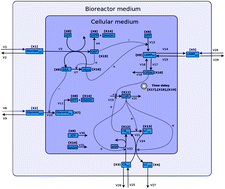Quantitative analysis of the dynamic signaling pathway involved in the cAMP mediated induction of l-carnitine biosynthesis in E. coli cultures
Abstract
L-(−)-carnitine can be synthesized from waste bioprecursors in the form of crotonobetaine. Such biotransformation is carried out in E. coli by the enzymes encoded by operons regulated by the cAMP receptor proteins. Non-phosphorylated sugars, such as glycerol are used as energy and carbon source since glucose inhibits cAMP synthesis. Until now little attention has been paid to the regulatory signaling structure that operates during the transition from a glucose-consuming, non-L-carnitine producing steady state, to a glycerol-consuming L-carnitine producing steady state. In this work we aim to elucidate and quantify the underlying regulatory mechanisms operating in the abolition of the glucose inhibiting effect. For this purpose we make use of the systemic approach by integrating the available information and our own experimentally generated data to construct a mathematical model. The model is built using power-law representation and is used as a platform to make predictive simulations and to assess the consistency of the regulatory structure of the overall process. The model is subsequently checked for quality through stability and a special, dynamic sensitivity analysis. The results show that the model is able to deal with the observed system transient phase. The model is multi-hierarchical, comprising the metabolic, gene expression, signaling and bioreactor levels. It involves variables and parameters of a very different nature that develop in different time scales and orders of magnitude. Some of the most relevant conclusions obtained are: (i) the regulatory interactions among glucose, glycerol and cAMP metabolism are far stronger than those present in the L-carnitine transport, production and degradation processes; (ii) carnitine biosynthesis is very sensitive to the cAMP signaling system since it reacts at very low cAMP receptor concentrations, and (iii) ATP is a critical factor in the transient dynamics. All these model-derived observations have been experimentally confirmed by separate studies. As a whole, the model contributes to our general understanding of the transient regulation through the signal regulatory structure, thus enabling more accurate optimization strategies to be used.


 Please wait while we load your content...
Please wait while we load your content...